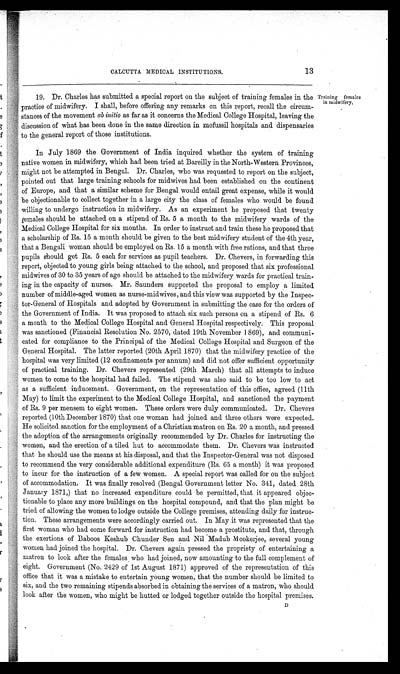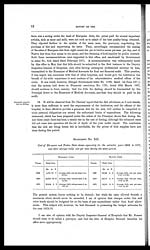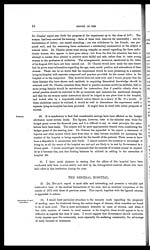Medicine - Institutions > Reports from medical colleges, schools and research institutions > Report on the Calcutta medical institutions > Calcutta medical institutions reports 1871-78 > Report on the Calcutta Medical Institutions for the year 1871
(23) Page 13
Download files
Individual page:
Thumbnail gallery: Grid view | List view

13
CALCUTTA MEDICAL INSTITUTIONS.
19. Dr. Charles has submitted a special report on the subject of training females in the
practice of midwifery. I shall, before offering any remarks on this report, recall the circum-
stances of the movement ab initio as far as it concerns the Medical College Hospital, leaving the
discussion of what has been done in the same direction in mofussil hospitals and dispensaries
to the general report of those institutions.
In July 1869 the Government of India inquired whether the system of training
native women in midwifery, which had been tried at Bareilly in the North-Western Provinces,
might not be attempted in Bengal. Dr. Charles, who was requested to report on the subject,
pointed out that large training schools for midwives had been established on the continent
of Europe, and that a similar scheme for Bengal would entail great expense, while it would
be objectionable to collect together in a large city the class of females who would be found
willing to undergo instruction in midwifery. As an experiment he proposed that twenty
females should be attached on a stipend of Rs. 5 a month to the midwifery wards of the
Medical College Hospital for six months. In order to instruct and train these he proposed that
a scholarship of Rs. 15 a month should be given to the best midwifery student of the 4th year,
that a Bengali woman should be employed on Rs. 15 a month with free rations, and that three
pupils should get Rs. 5 each for services as pupil teachers. Dr. Chevers, in forwarding this
report, objected to young girls being attached to the school, and proposed that six professional
midwives of 30 to 35 years of age should be attached to the midwifery wards for practical train-
ing in the capacity of nurses. Mr. Saunders supported the proposal to employ a limited
number of middle-aged women as nurse-midwives, and this view was supported by the Inspec-
tor-General of Hospitals and adopted by Government in submitting the case for the orders of
the Government of India. It was proposed to attach six such persons on a stipend of Rs. 6
a month to the Medical College Hospital and General Hospital respectively. This proposal
was sanctioned (Financial Resolution No. 2570, dated 19th November 1869), and communi-
cated for compliance to the Principal of the Medical College Hospital and Surgeon of the
General Hospital. The latter reported (20th April 1870) that the midwifery practice of the
hospital was very limited (12 confinements per annum) and did not offer sufficient opportunity
of practical training. Dr. Chevers represented (29th March) that all attempts to induce
women to come to the hospital had failed. The stipend was also said to be too low to act
as a sufficient inducement. Government, on the representation of this office, agreed (11th
May) to limit the experiment to the Medical College Hospital, and sanctioned the payment
of Rs. 9 per mensem to eight women. These orders were duly communicated. Dr. Chevers
reported (10th December 1870) that one woman had joined and three others were expected.
He solicited sanction for the employment of a Christian matron on Rs. 20 a month, and pressed
the adoption of the arrangements originally recommended by Dr. Charles for instructing the
women, and the erection of a tiled hut to accommodate them. Dr. Chevers was instructed
that he should use the means at his disposal, and that the Inspector-General was not disposed
to recommend the very considerable additional expenditure (Rs. 65 a month) it was proposed
to incur for the instruction of a few women. A special report was called for on the subject
of accommodation. It was finally resolved (Bengal Government letter No. 341, dated 28th
January 1871,) that no increased expenditure could be permitted, that it appeared objec-
tionable to place any more buildings on the hospital compound, and that the plan might be
tried of allowing the women to lodge outside the College premises, attending daily for instruc-
tion. These arrangements were accordingly carried out. In May it was represented that the
first woman who had come forward for instruction had become a prostitute, and that, through
the exertions of Baboos Keshub Chunder Sen and Nil Madub Mookerjee, several young
women had joined the hospital. Dr. Chevers again pressed the propriety of entertaining a
matron to look after the females who had joined, now amounting to the full complement of
eight. Government (No. 2429 of 1st August 1871) approved of the representation of this
office that it was a mistake to entertain young women, that the number should be limited to
six, and the two remaining stipends absorbed in obtaining the services of a matron, who should
look after the women, who might be hutted or lodged together outside the hospital premises.
Training females
in midwifery.
D
Set display mode to: Large image | Zoom image | Transcription
Images and transcriptions on this page, including medium image downloads, may be used under the Creative Commons Attribution 4.0 International Licence unless otherwise stated. ![]()
| Permanent URL | https://digital.nls.uk/74972671 |
|---|
| Description | 13 titles. Describes research work and conditions, treatments, vaccine production, medical education, public health and disease outbreaks. Extensive tables show mortality rates and patient admissions. These - some from asylums, jails, dispensaries, civil and police hospitals – will be useful to epidemiologists. |
|---|




